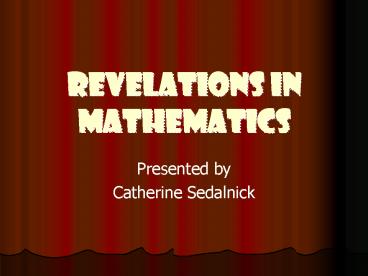Revelations in Mathematics - PowerPoint PPT Presentation
1 / 15
Title:
Revelations in Mathematics
Description:
Elliptic curves. Modular forms. Euler systems. Galois representations ... International Mathematics Union honored Wiles with a special silver plaque in 1998 ... – PowerPoint PPT presentation
Number of Views:58
Avg rating:3.0/5.0
Title: Revelations in Mathematics
1
Revelations in Mathematics
- Presented by
- Catherine Sedalnick
2
The many uses of Mathematics
- Within the last few decades, there have been many
discoveries in mathematics. - Some have had practical uses
- Some are better left as interesting theories
3
The Four Color Theorem
4
Four Muah ha ha!!!
- AKA The Four Color Map Theorem
- A map that is separated into regions can only use
four different colors - Adjacent regions cannot be the same color
- Adjacent means that a border is shared
- First Theorem to be proven by a computer
5
Things that make you go hmmm
- In 1852, Francis Guthrie came up with the 4 color
conjecture - Several early failed attempts at proving the
theorem - Attempts were made by
- Alfred Kempe in 1879 (proven to be wrong in
1890) - Peter Guthrie Tait in 1880 (proven to be wrong in
1891) - Heinrich Heesch attempted to use a computer
(1960s and 1970s) - Kenneth Appel and Wolfgang Haken finally proved
the four-color conjecture in 1976
6
What does this mean?
- Efficient algorithms have been made
- This is not really used for cartographers
- It is not practical because many things such as
lakes have to be the same color
7
To Fermat or not to Fermat
- 350 Years Later, Fermat's Last Theorem Finally
Proven
8
Lots of Information
- Pierre de Fermat came up with a theorem in the
1630s that, until recently, had not been solved. - Fermat claimed that there are no positive
integers for which xn yn zn when n is greater
than 2. - Andrew Wiles, from Princeton University, finally
did it!!! Yay!!! ? - He was intrigued from the time he was a teenager
and decided to pursue a career in mathematics.
9
Second times a charm
- In 1986, mathematician Ken Ribet and the
Taniyama-Shimura conjecture - June 23, 1993, Wiles announced his solution
- In 1994, the problem was presented again with the
help of a colleague, Richard Taylor.
10
- The new manuscript is over 100 pages of complex
math. - The manuscript included the following
- Selmer groups
- Hecke algebras
- Elliptic curves
- Modular forms
- Euler systems
- Galois representations
- Number Theory and Geometry were used to solve
this theorem.
11
And the prize goes to
- A prize established in 1906 to reward the first
valid proof of Fermat's Last Theorem - Too late for the Field Medal
- International Mathematics Union honored Wiles
with a special silver plaque in 1998
12
Roman A.Polyak
13
Mathematics to the Rescue!!!
- Dr. Roman Polyak found ways to treat cancer by
using abstract algebra on March 5, 2008 - Polyak works in the field of mathematical
optimization at George Mason University - His work is accurate to the 10th digit.
- Application of optimization
- Image processing, medical diagnostics and
finding the optimal distribution of power across
a grid
14
Dr. Roman Polyak continued
- Because he was a refusenik, he was unable to
publish his research in the Soviet Union - Family, friends, and math sustained him.
- He said that "If I couldn't do my mathematics, I
would be spiritually dead."
15
References
- Dr. Roman Polyak http//www.nsf.gov/discoveries/di
sc_summ.jsp?cntn_id111193orgNSF - Dr. Roman Polyakhttp//mason.gmu.edu/rpolyak/poly
ak.html - Fermats Theorem
- http//www.nsf.gov/discoveries/disc_summ.jsp?cntn_
id100029orgNSF - Problems solved
- http//en.wikipedia.org/wiki/Unsolved_problems_in_
mathematicsProblems_solved_recently - Four Color Theorem
- http//en.wikipedia.org/wiki/Four_color_theorem
- http//en.wikipedia.org/wiki/Four_color_theorem































